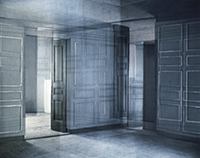 Dreams always take place: Spaces, places, rooms, and furniture, inside and around us
Dreams always take place: Spaces, places, rooms, and furniture, inside and around us
Studying Organisational Dynamics through a Psychoanalytic Lens
Organizational life takes place in spaces, outside: between trees and houses, on streets and fields, in cars and trains and flights, and in rooms: between walls with windows and doors, between ceilings and floors and between all kinds of furniture, on chairs to sit on and at tables to work at, with laptops to write on and to communicate by, with all the people that are not physically present in the room, but also participate in organizational life.
Life starts inside the mother, birth passes, and the baby´s life is transformed, as the baby is held by parents and brought ‘home, where we start from’.
Creative imagination is stimulated by wondering about what’s inside the mother and what’s inside the oven and other hidden spaces that the parents try to keep for themselves. Hierarchies lend metaphors from positions in space that may be related to the differences in heights between parents and child. Projections go onto or into the bodies of others, that maybe are able to contain the material and return it in a matured way – or not. The inner world is built up of separated spaces like the Ego, the Id and the Super-ego with the unconscious part of the Ego taking care of regulating the traffic between them. Our memories are often organized by the interior of a house or otherwise related to landscapes and buildings.
In the late 20th century, the Spanish sociologist Manuel Castells, saw the globalized world as holding a tension between the space of flows and the space of places, the first for the rich and smart in timeless time, for money and trade, the last for the workers trapped in a local existence and bound to clock time. Later he realized that the space of flows and the space of places co-exist and that contradicting interests are articulated in both spaces.
The utopian days of the information age are over and they have given birth to the recognition of the dystopian aspects of the IT-revolution. The refugee challenge in Europe has made it quite clear, that the network society isn’t a global safety network. Boundaries that have been invisible suddenly become present in a very massive way. The freedom to travel all over the world on the www meets another reality, that body, room, boundary, space, and place doesn’t fly that fast.
Many organisations are located across borders where work is going on round the clock. Employees are online 24/7, but still they have bodies with needs and desires. People need lunch, coffee breaks, sometimes hit the doorframe when entering a room, sit on comfortable or uncomfortable chairs, enjoy the perfume of a colleague, etc.
Groups, organizations, and individuals construct, deconstruct and destroy physical structures that provide protection, hierarchy, identity, etc. according to their conscious and unconscious dreams, thoughts and feelings. The interaction between structures and actors provide and restrict possibilities inside and around us.
Changes happen all the time. Organisations merge and divide, offices are rearranged, new open spaced are established. New buildings are built in old places and old buildings with new internal designs are created. For the employees, it is a challenge to adapt to new arrangements, and if no “inner rearrangement” takes place, the organisation might remain as always. As Bridges put it: “When a change happens without people going through a transition, it is just a rearrangement of the chairs.”
The dream of one person might be a nightmare for another. Spaces, places, and rooms affect us deeply. A question could be: why are some rooms better suited to their purpose, than others? Why do some places make us feel lonely and scared, while others make us feel home away from home? How do we design and create spaces, places, rooms, and furniture, with room for creativity, collaboration, and authority…?
We welcome your submissions on the issues below – or other relevant issues you have encountered. Please see the ISPSO AM17 webpage for further inspiration and information:
– How does the staging of the work place promote and inhibit cooperation, leadership, and task performance?
– How does the staging of the work place authorize and undermine the authority of participants?
– How do conscious and unconscious motives interact in the ways we deal with spaces and furniture?
Keynote speakers:
Peter Greenaway: Understanding space
Peter Greenaway is a British film director, screenwriter, and artist.
Helle Søholt: People First Design
Helle Søholt is a founding partner and CEO of Gehl architects.
Richard Morgan Jones: The Body that Dreams, the Organisational Space it Desires
Richard Morgan Jones is a Psychoanalytic Consultant and Psychotherapist.
Programme:
Monday July 3rd: Professional Development Workshops
Tuesday July 4th: Professional Development Workshops
Wednesday July 5th: Professional Development Workshops
Thursday July 6th: Members Day/Professional Development Workshops
Friday July 7th: Symposium
Saturday July 8th: Symposium
Sunday July 9th: Symposium
Every Morning: Social dreaming and Every Afternoon: End of day reflection
See: Professional Development Workshop (detail)
See: Symposium Papers (list)
Optional Social activities:
See: Social program
